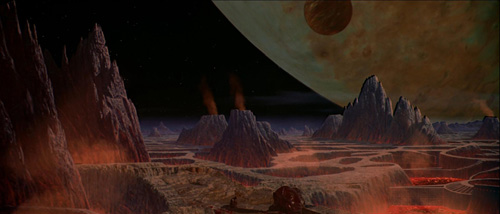40 Eridani system
| Affiliation | United Federation of Planets[1] |
| System Type | Trinary[2] |
| Primary Star | Name: 40 Eridani A (Omicron 2 Ceti)[2] Spectral Class: Type K1V[2] Absolute Magnitude: 6.0[2] Planets: I: Class B[2] II:[2] Vulcan[3] (Class M)[1] III:[2] T'Khut[4] (Class G)[2] IIIa:[2] Delta Vega[4][5] (Class M)[5] |
| Companion Stars | Distance from Primary: 400 AUs Orbital Period: 248 years[2] Name: 40 Eridani B[2] Spectral Class: Type F VII[2] Absolute Magnitude: 11.2[2] Planets: None[2] Name: 40 Eridani C[2] Spectral Class: Type M4V[2] Absolute Magnitude: 12.3[2] Planets: None[2] |
| Other Stellar Objects | Vulcan Space Central[6] |
| Advertising |
Located a mere 16.5 light years from the Sol system,[7] the 40 Eridani system — also known as the Vulcan system — is a trinary star system consisting of a Type K1V orange dwarf primary and two companion stars: a Type F VII white dwarf and a Type M4V red dwarf. The system's location in the Vulcan Sector (aka Sector 005) in the Beta Quadrant, is strategically important—its position at the heart of Federation space[2] made it a tempting target for Dominion forces during the Dominion War.[8]
Primary Star
The system's primary star, 40 Eridani A, is a Type K1V orange dwarf orbited by three planets. The first planet is Class B.[2] The second and third planets—Vulcan (Class M) and T'Khut (Class G)—share an orbit, [4][2] which regularly gave magnificent views of T'Khut and its moon, Delta Vega,[9] from the Vulcan surface.[4][5]
Companion Stars
The system's companion stars are 40 Eridani B, a Type D VII white dwarf, and 40 Eridani C, a Type M4V red dwarf.[2]
Notes and References
- ↑ Jump up to: 1.0 1.1 Roddenberry, Gene (Executive Producer). "The Cage". Star Trek, season 0, episode 0 (Production number 01). Directed by Robert Butler. Written by Gene Roddenberry. Released 1986. Desilu Productions. 1965.
- ↑ Jump up to: 2.00 2.01 2.02 2.03 2.04 2.05 2.06 2.07 2.08 2.09 2.10 2.11 2.12 2.13 2.14 2.15 2.16 2.17 2.18 2.19 2.20 2.21 Mandel, Geoffrey. Star Trek: Star Charts. Pocket Books, 2002.
- ↑ Roddenberry, Gene (Executive Producer). "The Enemy Within". Star Trek, season 1, episode 5 (Production number 05). Directed by Leo Penn. Written by Richard Matheson. Desilu Productions. 6 October 1966.
- ↑ Jump up to: 4.0 4.1 4.2 4.3 Roddenberry, Gene (Producer). Star Trek: The Motion Picture. Directed by Robert Wise. Story by Alan Dean Foster. Screenplay by Harold Livingston. Paramount Pictures. 7 December 1979.
- ↑ Jump up to: 5.0 5.1 5.2 Abrams, J.J. & Damon Lindelof (Producers). Star Trek. Directed by J.J. Abrams. Written by Roberto Orci & Alex Kurtzman. Paramount Pictures. 8 May 2009.
- ↑ Roddenberry, Gene (Executive Producer). "Amok Time." Star Trek, Season 2, Episode 5. Directed by Joseph Pevney. Written by Theodore Sturgeon. Desilu Productions, 15 September 1967.
- ↑ "Home." Star Trek: Enterprise, episode 79. Television. 22 October 2004.
- ↑ "In the Pale Moonlight." Star Trek: Deep Space Nine, episode 543. Television. 13 April 1998.
- ↑ Although not explicitly stated to be located within the Vulcan system, the most likely location for the Delta Vega seen in the film Star Trek would be the previously-unnamed moon of Vulcan's sister world, T'Khut. Established to be close enough to loom large in the Vulcan sky in Star Trek: The Motion Picture, this moon is near enough to Vulcan to not only provide the view of that planet's destruction during the Battle of Vulcan (as witnessed by Spock (Prime)), but also for Spock (Kelvin) to leave Kirk without a significant detour. Additionally, the Enterprise's warp drive was damaged in the battle (the Enterprise warp nacelles collided with the wreckage of the U.S.S. Mayflower's saucer section, and the bridge viewscreen didn't show the warp distortion until well after Kirk was left at Delta Vega), making it impossible for the ship to have traveled out of the system in the first place.


